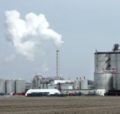Difference between revisions of "Chem395:Welcome"
(→What is sustainable manufacturing?: tweak) |
(Add navigation template) |
||
| Line 1: | Line 1: | ||
__NOTOC__ | __NOTOC__ | ||
| + | |||
| + | {{Chem395 navigation}} | ||
| + | |||
== Chemistry 395: Sustainable Manufacturing == | == Chemistry 395: Sustainable Manufacturing == | ||
Revision as of 02:50, 17 October 2007
MANUFACTURING (Chemistry 395) |
| MAIN PAGE |
|---|
| Syllabus — Schedule |
| Welcome page Contact Dr. Walker |
| This week |
| Today's tasks |
| Course units 1 - 2 - 3 - 4 - 5 - 6 - 7 8 - 9 - 10 - 11 - 12 - 13 - 14 |
| Blackboard site |
|
|
| Course content |
| Assignments |
| Practice problems |
| Discussions |
|
|
| General wiki help |
| Basic editing Create an account Protocols Tutorial Demo, for practice |
Chemistry 395: Sustainable Manufacturing
Welcome to the online course on Sustainable Manufacturing! Please take a look at the Chem395:Syllabus and Chem395:Schedule to get an idea of what work is involved, and read the section below for a general introduction.
What is sustainable manufacturing?
The world's resources are running out, and therefore sustainable manufacturing is likely to become a necessary part of our future. Our goods will need to be designed for safe and efficient production, and they should be easily re-used or recycled when they become obsolete or broken. Our processes will need to use the minimum of energy and materials, with the minimum of waste. We must completely rethink how manufacturing is organized, to ensure that sustainability lies at the heart of all planning and design. In terms of a business model, a company will need to include all environmental considerations in the balance sheet. Government should lay out the right infrastructure to allow sustainable industries to flourish, and academia should facilitate the development of sustainable technologies.
This should be seen as part of a wider movement towards sustainable development. This worldview considers that human civilization can continue to live comfortable in prosperity, but only if our entire society is restructured to be environmentally efficient. It states that we need to design our cities and towns with "green" housing and sustainable transportation. Our society should not be centered on consumption and consumerism, but on careful stewardship of our resources.
There are many aspects to sustainable manufacturing - engineering and chemistry, process design, product life cycle, quality control, waste and hazardous materials, energy and transportation, as well as how the enterprise is managed. This course aims to cover all of these aspects.
